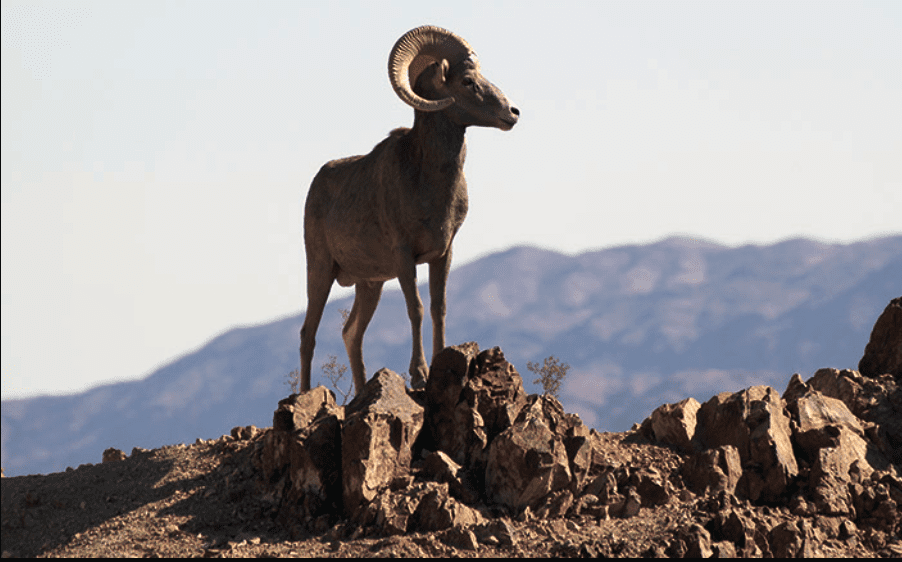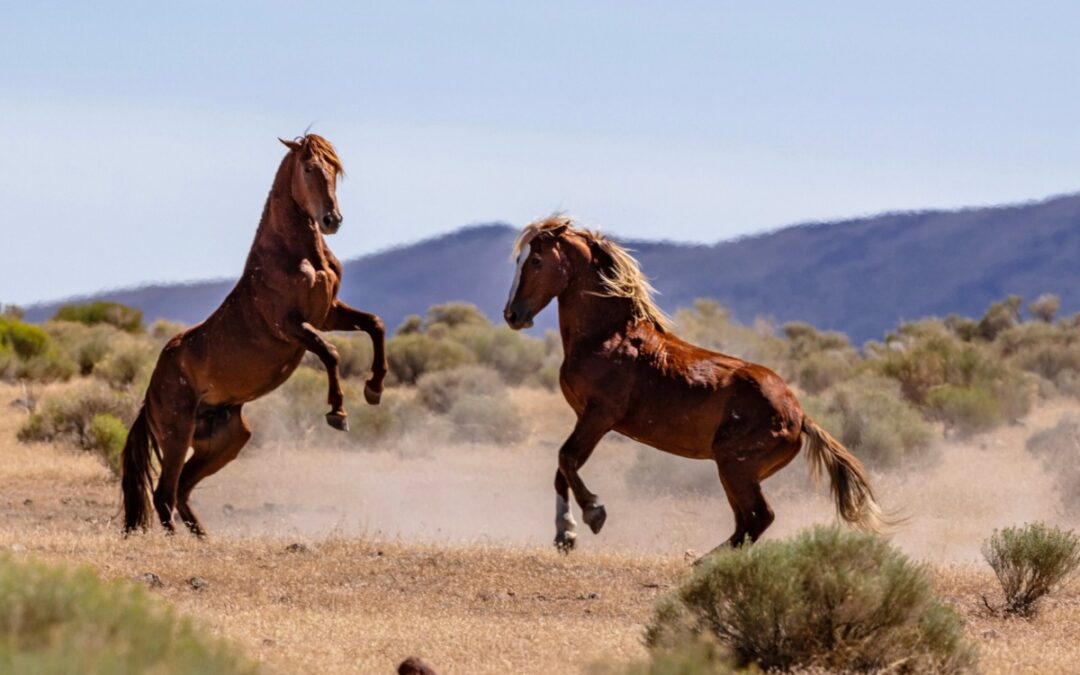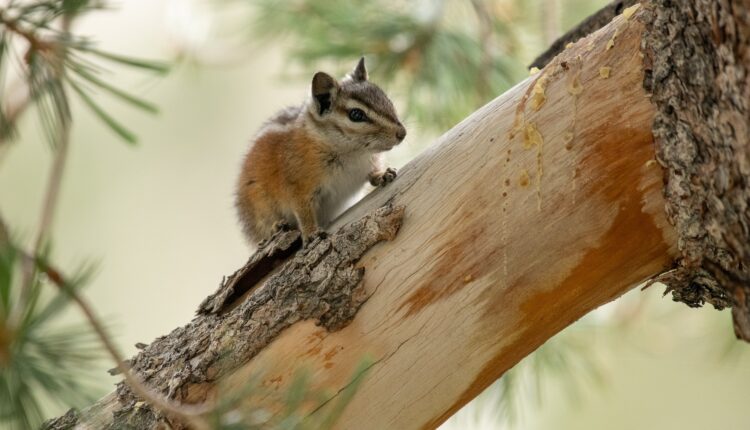
Desert bighorn sheep -official state animal- have been roaming the state since ancient times and were prominent in indigenous petroglyphs. (Desert Bighorn Sheep of the Lake Mead NRA / National Park Service)
Even though Southern Nevada is home to the country’s highest population of desert bighorn sheep, it’s impossible to predict an encounter with our official state animal.
Yes, this majestic wildlife can be found in the valley, but they generally roam in herds in rugged, vertical terrain like rocky, mountain ranges; places where they can climb with their cloven hoofs to escape predators or anyone who might hurt them, including humans.
“Casual hikers may have a chance to see them in the ranges around the valley,” notes Doug Nielsen, NDOW Conservation Education Supervisor in Las Vegas. “As with any wildlife, it’s a guess as to when an animal is going to be at a particular place,”
Desert bighorn sheep have been roaming the state since ancient times and were prominent in indigenous petroglyphs. The population exploded in the 1600s, but by the late 1800s, they faced extinction due to disease, hunting, and increased competition for food, according to the National Park Service (NPS).
These days, the sheep are making a healthy comeback thanks to reintroduction efforts.
“They’re an amazing animal,” says Nielsen. “They live in one of the harshest environments in the world and they’re doing well.”
Boulder City Bighorn Bonanza
Despite the desert bighorn sheep’s elusiveness, and their tendency to blend into the background, it is possible to see these herbivorous desert dwellers in person.
Nielsen has three suggestions for increasing your chances of seeing one:
- Sit
- Watch
- Use a good pair of binoculars
“We tend to think ‘If I put more miles under my feet, I’m going to increase my chances,’” says Nielsen, “but if you’re moving you’re not watching.”
A popular spot for viewing desert bighorn sheep is Hemenway Park in Boulder City. You can find them grazing at the park all day, but primarily in the morning and particularly from April through November.
Desert bighorn sheep are so common in Boulder City that the town has its own Boulder City Ram Cam so you can watch the state animal from the comfort of home.
If you prefer to see one at the park in person, however, Nielsen suggests sitting in the shade of a covered veranda.
“They’re there to eat the clover and find a little respite from the heat,” says Nielsen. “Respect them by giving them space. They are wild animals. They just tolerate human presence as the cost of doing business.”
If you get lucky, “they’ll walk within a few feet of you,” he says. If you get too close, “they’ll leave.”
Nielsen advises enjoying desert bighorn sheep from a distance of about 30-40 yards away. If they start stamping their feet, flipping a tail, or acting agitated, you’re probably too close and making them uncomfortable.
“With today’s cell phones, you can always do a digital zoom,” says Nielsen, adding, “We don’t want the animals … running into the road or the highway because they aren’t going to win.”
If you happen to visit Hemenway Park in the fall, you could be in for a special show. Autumn is mating season, called the “rut,” when the rams (male sheep) compete for females by slamming their horns, or “curls,” together.
The male’s circular horns weigh up to 30 pounds and each headdress is as individual as a fingerprint. None are an exact copy. Typically, the larger the horns, the older the ram.
“It’s loud,” says Nielsen of the rams slamming their horns together. “You can hear them really cracking and it’s amazing to see how much energy they expel. The average person is never going to see something like this, except in a movie or National Geographic.”
Desert Bighorn Sheep Spotting Tips
The Desert Wildlife Refuge, north of Las Vegas, is home to tons of wildlife including up to 1,000 desert bighorn sheep, depending on the season. Some recommended areas for viewing them include the Black Hills area, and the east Desert Mountain Range, Peek-a-Boo Canyon and the Quail Springs guzzler.
Here are some tips from the U.S. Fish and Wildlife Service to improve your chances of seeing them there:
- Use your binoculars or a spotting scope early to mid-morning with the sun behind you
- Look for light-colored parts of their body that stand out against the rocky terrain
- If it’s fall, winter, or spring, desert bighorn sheep can be found at somewhat lower elevations
- In the summer, look for sheep close to a water source.
- Be patient. It may take many hours before spotting any bighorn, if at all.
Other places to see desert bighorn sheep
Some additional hot spots for sheep spotting in Southern Nevada are Ash Meadows National Wildlife Refuge, Red Rock Canyon National Conservation Area, Valley of Fire State Park, and Lake Mead National Recreation Area.
In Northern Nevada, users on Reddit recommend Walker Lake near Reno in the springtime.

Promulga el Condado Clark nuevas reglas para mejorar el bienestar animal y reducir la población en refugios
El Condado Clark anunció el martes 4 de febrero de 2025 algunos cambios y adiciones importantes al código municipal, enfocados en abordar la cría...

Bureau of Land Management prepares for major wild horse gather in Nevada
The Bureau of Land Management will begin a wild horse gather in Nevada's Triple B Complex on Nov. 1, 2024, aiming to manage the herd size and...

Go Batty: October is Bat Appreciation Month
While Halloween is undoubtedly the biggest jewel in October’s crown, there’s another reason to celebrate it: October is Bat Appreciation Month....

Exige Las Vegas el uso de microchips en mascotas; multas y cárcel para infractores
A partir del 1 de agosto, todos los perros y gatos de cuatro meses o más dentro de los límites del Ayuntamiento de Las Vegas deben tener un...

These 8 endangered animals in Nevada need your help
Learn more about eight endangered animals in Nevada and how you can save them from going extinct. Nevada is largely desert, but it is also quite...

Dog-friendly hotels in Las Vegas, Baker, Tonopah, Ely, and Baker
When it comes to traveling for some of us, our dogs are like our American Express — we can’t leave home without them. Fortunately, when we hit the...





